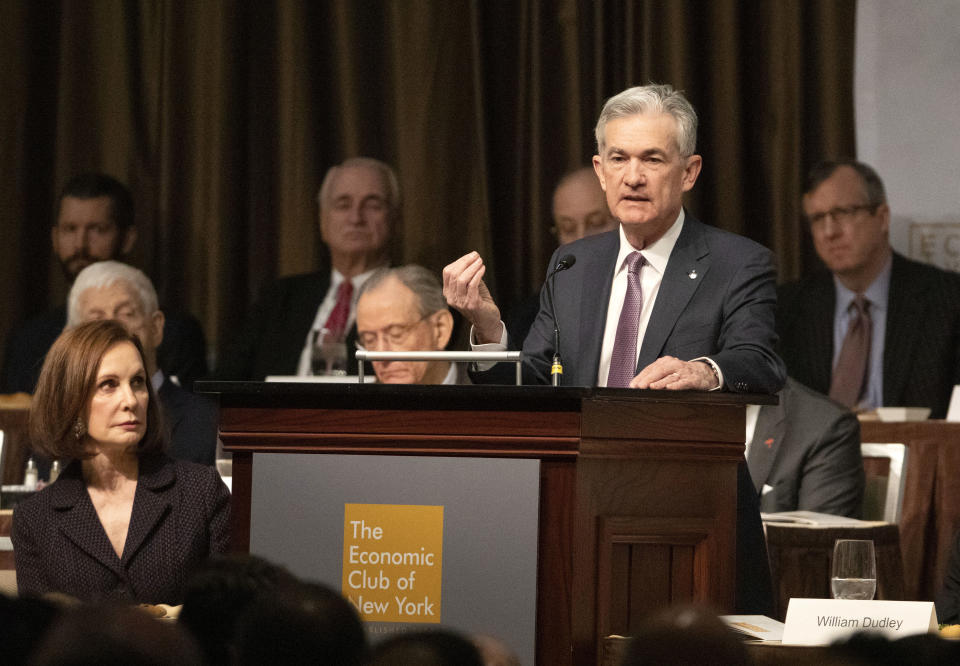Why Powell's comments mattered this week
The biggest market event of the past week was Federal Reserve Chair Jerome Powell’s speech on Wednesday at the Economic Club of New York.
“Interest rates are still low by historical standards, and they remain just below the broad range of estimates of the level that would be neutral for the economy—that is, neither speeding up nor slowing down growth,” Powell said.
And for those not steeped in the world of parsing statements from Fed officials for signals about policy decisions, the only words that really mattered from Powell were “just below.”
Following Powell’s comments, stocks ripped higher with the major U.S. indexes gaining more than 2% across the board. The market action indicates that investors saw Powell’s phrasing as suggesting a potentially less aggressive path for interest rate hikes next year.
Markets also interpreted this phrase as standing in intentional contrast to Powell’s early-October utterance that interest rates were “a long way from neutral.” The neutral rate of interest is the level of interest rates economists think supports an economy that operates at full employment with price inflation meeting the Fed’s 2% goal.
How any investor or economist or strategist interprets Powell’s commentary is up to him or her. I am partial to the idea that markets moved so violently on Wednesday because broad market positioning was betting on lower stock prices and a stronger dollar — positions that ended up wrong-footed on Wednesday — not because Powell drastically shifted the Fed’s outlook.
But any one investor’s interpretation of the Fed chair’s comments is less important than accepting that right now, any commentary from Powell is going to be a market mover. That is the signal to take away from this past week’s events.

Some on Wall Street, however, are somewhat divided on whether Powell really changed the Fed’s outlook as drastically as Wednesday’s action would suggest.
“Directionally, we agree that Fed commentary has shifted somewhat in a dovish direction over the past few weeks,” said economists at Goldman Sachs on Friday. “In the wake of tighter financial conditions and lower oil prices, the emphasis has shifted from a need for restrictive policy to the importance of data dependence while the tone on inflation expectations also appears to have shifted somewhat in a dovish direction … We, however, think that markets have overstated the extent of the shift for three reasons.”
To Goldman, markets for one thing overstated the importance of Powell’s October comments, which were made in an interview with PBS and not a prepared speech. Second, the firm thinks the market’s reaction implies that investors didn’t read the entire key sentence, stopping at “just below.” And though the Fed’s signature language on the neutral rate may now be “just below” instead of a “long way away,” Goldman thinks the Fed’s overall outlook for the labor market and economy remains notably unchanged, implying a quarterly pace of rate hikes remains likely in the time ahead.
At Capital Economics, Paul Ashworth writes that Powell’s revised formulation of how far the Fed remains from its estimated neutral is not a “genuine shift” in the chair’s stance.
“The minutes of the Fed’s early November FOMC meeting revealed that another rate hike was coming ‘fairly soon’, i.e. in December, and that ‘further rate hikes’ would be required,” Ashworth writes. “Admittedly, market sentiment has deteriorated since early November, but the incoming economic data have held up well. Powell said nothing this week to suggest he was more worried about the real economic outlook or that inflation would undershoot the target.”
David Zervos, chief market strategist and head of global fixed income strategy at Jefferies, said Friday, however, that Powell’s commentary “amounted to a full retraction” of his early-October comments. “[Powell’s] gaffe in early October, and his stubbornness in retracting it, created some wild market swings,” Zervos writes. “But as with all good policy-error related opportunities, this one too had to come to an end.”
On December 19, Powell will speak with reporters after the Fed’s latest monetary policy decision is announced. And in 2019, Powell will hold a press conference after all eight of the Fed’s scheduled policy announcements. (This week, Powell had been scheduled to speak before the Senate’s Joint Economic Committee on Wednesday, but the declaration of a national day of mourning following the death of President George H.W. Bush puts that appearance in question.)
Now over time, investors may grow less excited about hearing from Powell. Indeed, part of Powell’s communication strategy of increasing his comments may be aimed at tamping down market volatility around any one of his public utterances. Additionally, the economic outlook may obviously change or the Fed may alter its forecasts or policy statement in some way so as to make follow-on comments from the Fed Chair moot.
But whether you think the market gets its interpretation of the Chair’s future comments right or wrong is less important than knowing his comments will be market movers.
—
Myles Udland is a writer at Yahoo Finance. Follow him on Twitter @MylesUdland
